Additional author: Whitney Richardson, University of Georgia Center for Urban Agriculture, with technical assistance from Makenzie English, University of Georgia Department of Horticulture Program Assistant.
Introduction
Heirloom vegetables are “old school” vintage varieties that have been around for generations. These varieties are open pollinated and typically anywhere from 50 to several hundred years old, with seed saved and passed down from one generation to the next. Heirloom varieties have become very popular with today’s gardeners as they often have superior flavor quality. Because heirlooms are typically open-pollinated, the seed can be saved and will breed back true-to-type. There are heirloom seeds available for many types of vegetables, and several of these may look substantially different from their newer, hybrid relatives.
Saving Heirloom Seed
Traits from new hybrid improved varieties of vegetables will begin to segregate after one generation, so saving seed is not recommended. Most heirloom seeds, however, are open-pollinated and will produce true to type when seeds are saved. Before storing seed that was collected, make sure it is completely mature and dry. If it is not, this could lead to moldy seed, and it will begin to deteriorate quickly. There is usually a 65%–80% percent germination rate from collected seed, with three-quarters of those seedlings producing satisfactory plants. For more information on seed saving and germination visit UGA Extension publications Starting Plants from Seed for the Home Gardener and Variety Selection and Seed Saving for Organic Growers.
Challenges in Growing Heirloom Varieties
Heirloom varieties can be a little more challenging for the home gardener to grow. Just obtaining seed for purchase can sometimes take considerable time and effort. Look for seed companies that specialize in old and heirloom varieties. Most major seed companies do, however, usually offer some heirloom seed. Another obstacle to overcome with heirloom varieties is that they are typically much less resistant to common diseases and other pest issues. Hybrid varieties have been developed to improve resistance and other qualities to make them easier to grow. Unfortunately, sometimes in the hybridization process, the flavor and some of the unique characteristics of those vegetables may be lost. This is the biggest reason why heirloom varieties are still popular. More careful management of water, seeding depth, and insect and disease management are crucial when trying to produce healthy heirloom vegetables. In addition, storage shelf life is normally shorter for heirloom varieties.
Site Selection and Planning
Like most vegetables, heirloom varieties do best when planted in well-drained soil in an area that receives 6 hours or more of sunlight. Heirloom tomatoes, peppers, and eggplants, as well as broccoli, cauliflower, and cabbage should be started indoors to produce strong transplants. Use a good germinating mix to start transplants in a greenhouse or well-lit room. Most transplants will need 4–6 weeks from sowing to develop before being planted in the garden.
Most heirloom tomatoes will be an indeterminate variety and will need some type of staking or trellis to grow on. Vintage beans and peas are normally vining climbers and will need some structure to grow on. Sample soil to test the pH and fertility levels of the garden site. Just like standard vegetables, a pH of 6.2–6.8 is ideal. Fertilize at planting and then at intervals as needed during the growing season. Provide supplemental irrigation when needed to deliver approximately 1–2 in. of water every week. Use mulch, weed fabric, and mechanical means to keep weeds under control. Routinely scout plants for the presence of insects and diseases and provide appropriate control as needed.
Suggested Heirloom Varieties to Grow in Georgia
Lima and Butter Beans
- ‘Christmas Lima’ is a good variety for the Southeast. Climbing vines produce large seeds that are white with maroon streaks and have a wonderful flavor.
- ‘Jackson Wonder Bush’ is a productive and drought-tolerant 1880s vintage heirloom from Georgia. Seeds are buff colored with purple and black mottling.
- ‘Red Calico’ is a hardy and prolific butter bean variety with a dark burgundy seed coat. This butter bean has been maintained by the Thweat family in Tennessee since 1794.
- ‘Snow on the Mountain’ is a beautiful, heavy-producing pole lima from the 1800s. It has deep maroon seeds with white markings.
Pole, Snap, and Dry Beans

- ‘Cantare’ is a French variety with straight dark green pods. They range from 4–5-in. pods and are stringless.
- ‘Cherokee Trail of Tears Pole’ is an heirloom pole bean that was carried by Cherokee Indians on the Trail of Tears. They have purple-striped pods with shiny black seeds.
- ‘Contender’ is a bush bean that has good yields and high-quality pods.
- ‘Greasy Cut Short Pole’ has leaves and pods that are shiny, giving a greasy appearance. These are good eaten as snap beans.
- ‘Jacob’s Cattle’ is a small, pretty bean that is pure white with deep maroon splashes. It is excellent quality for baking and soups.
- ‘Thai Soldier Long Bean’ comes from Thailand and has reddish tiger stripes which can grow to a foot long. The beans are firm and flavorful.
- ‘Purple Pod Pole’ was discovered in the Ozark Mountains by Henry Fields in the 1930s. They grow 6 ft tall with tender and round 5–7-in. stringless pods. They turn green when cooked.
- ‘Red Swan Bush’ has a stringless snap and is one of the more unusual colored beans. It is a deep red with pink colors and great flavor.
- ‘Urizun Japanese Bean Winged’ has tropical looking unique pods with prolific vines. They come from Japan and are great in soups or steamed.
Basil

- ‘Genovese’ comes from the Italian Riviera that is an essential to many Italian
staples, like basil pesto. It is known for its great flavor.
Carrot
- ‘Pusa Asita Black’ is well suited for the South and performs better than other
carrots in extreme heat. The color gets a darker purple (almost black) as it
matures and is richer and sweeter than a regular orange carrot. - ‘New Kuroda’ roots can power through tough soils and high temperatures. It
is sugary sweet, and the texture is ultra-fine grained.
Corn
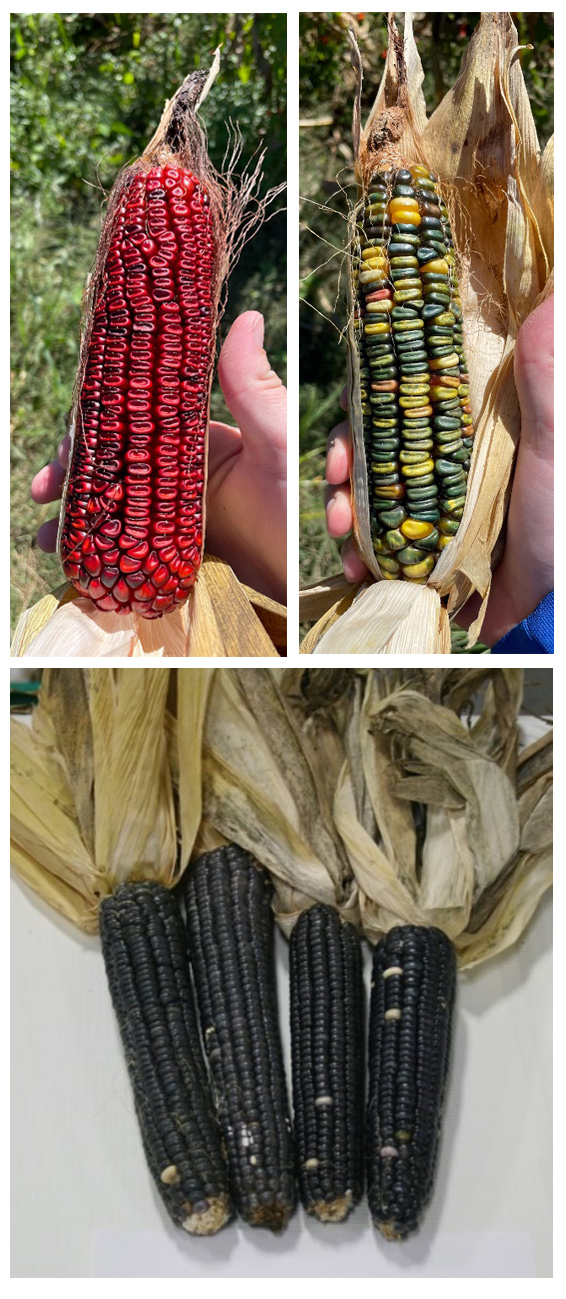
Top left: 'Oaxacan Green' corn;
Bottom: 'Hopi Blue' corn.
- ‘Bloody Butcher’ is a flint corn used for making flour or for decoration. The
ears are bright red. - ‘Country Gentleman’ is a popular old-fashioned shoe peg variety with irregularly spaced white kernels.
- ‘Golden Bantam’ was first introduced in 1902. This is the corn all others were compared to.
- ‘Hopi Purple’ has been grown in the high desert under dryland farming practices for many generations. Striking purple to violet rose stalks produce 8-in. ears.
- ‘Oaxacan Green’ is a popular variety that can be used to make green cornmeal. It is very drought tolerant. Some use it for its ornamental qualities as well.
- ‘Strawberry Popcorn’ is an old variety and grows 2–3-in. ears that are excellent for decorations in the fall then popping in the winter.
- ‘Stowell’s Evergreen’ was the standard, late-season white sweet corn before ‘Silver Queen’. Ears are 8–9 in. long.
Cucumbers
- ‘Lemon’ produces many lemon-colored and lemon-shaped fruit on fast-growing vines.
- ‘Suyo Long’ is popular for eating fresh. It is a large, ribbed, dark green color that can grow up to 18 in.
- ‘White Wonder’ is an old variety that matures to an ivory white color. The 7-in. fruit are easy see at harvest.
Eggplant
- ‘Chinese String’ is a high yielding plant that produces 10–15 in. long fruit with lavender skin and snowy white flesh. Is very sweet, slender, and tender.
- ‘Ping Tung’ is a Chinese eggplant that is purple in color and up to 18 in. long and 2 in. in diameter.
Leeks
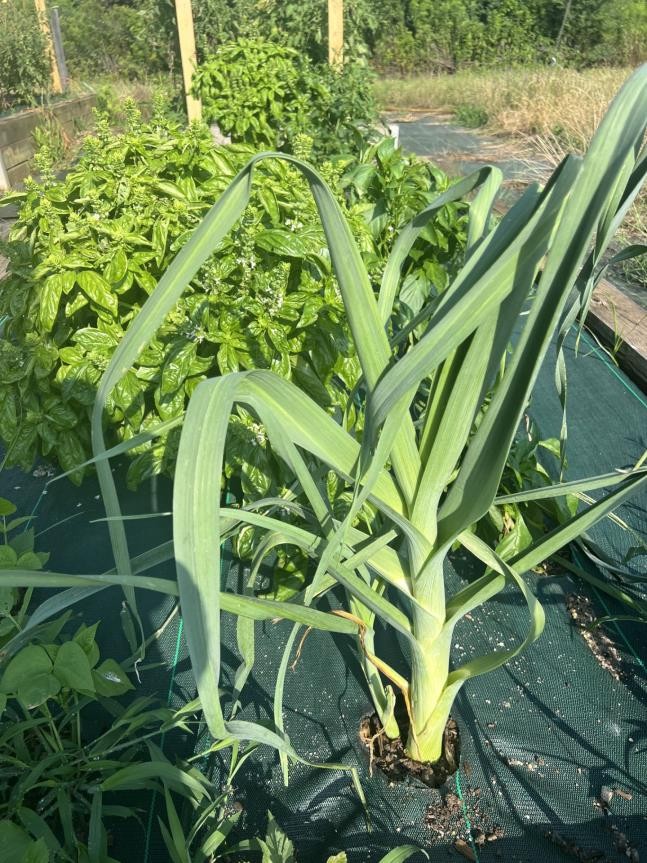
- ‘Bulgarian Giant Leek’ is a long and thin variety with light green leaves. They are great for soups or a stir fry.
Lettuce
- ‘Deer Tongue’ is a pre-1900 heirloom that is named for its pointed leaves and thick mid-rib. It is heat-tolerant and slow-bolting.
- ‘Tennis-ball’ was a very popular lettuce in the vegetable garden at Monticello. Tennis-ball lettuce has been grown since the late 18th century, and it is the parent of Boston lettuce types.
Melons
- ‘Hearts of Gold’ is a very popular old-timer. The 3 lb melons have thick, fine-grained flesh with spicy flavor. Flesh is salmon orange in color.
- ‘Jenny Lind’ grows to 1–2 lb with sweet, lime green flesh. It is an heirloom from New Jersey that was named in 1846.
Okra
- ‘Burgundy’ has deep burgundy pods that are 6 in. long. It gets 4 ft tall, and the pods are tender when cooked.
- ‘Jing Orange’ is a deep red-orange color okra that ranges from 6–8 in. pods. They are known to be tender and colorful.
- ‘Longhorn’ has long pods that are tender up to 6–8 in. long. It dates from the 1880s.
- ‘Star of David’ is a flashy okra variety. It has thick pods that look like the Star of David when sliced open.
Peppers, Sweet and Chili
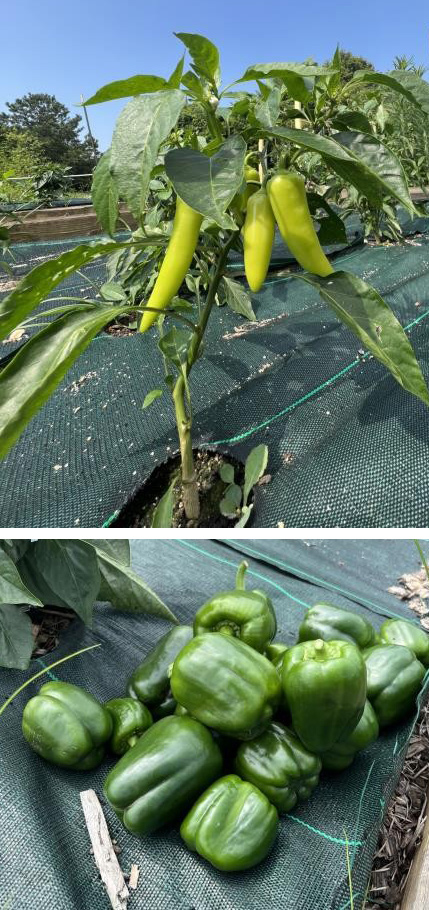
Wonder’ Bell Peppers
- ‘Banana Pepper’ is a sweet wax paper that can reach 6–7 in long. It is a translucent ivory color then ripens to a red orange.
- ‘California Wonder’ is one of the oldest and largest bell peppers available. It is a sweet green pepper that ripens to a vibrant red.
- ‘Jimmy Nardello’ is a sweet Italian pepper that does well in most areas. It is a long, thin-skinned pepper that dries easily and has a rich flavor.
Potatoes
- ‘Ruby Crescent Fingerling’ has small tubers between 2–6 in. long. Ruby-red skin covers deep yellow flesh.
- ‘Russian Banana’ is a fingerling potato that is yellow fleshed with a pleasantly waxy texture. It varies from finger size up to the size of an actual banana.
Southern Peas or Cowpeas
- ‘Calico Crowder’ is a medium-sized heirloom climbing crowder pea that is white with maroon splotches. It is good fresh or dried.
- ‘Kreutzer’ is an excellent cowpea which produces quantities of attractive beige-and-brown cowpeas with darker brown specks.
- ‘Pink-Eye Purple-Hull’ has cream colored seeds with maroon eyes in pods which turn purple at maturity.
They are vigorous, heat-loving, and drought-tolerant plants with little vining. - ‘Washday’ is so named because they cooked up fast on busy washdays. This tan yellow variety is a good yielder that makes a tasty soup. It is a half runner type from the 1800s.
Radish
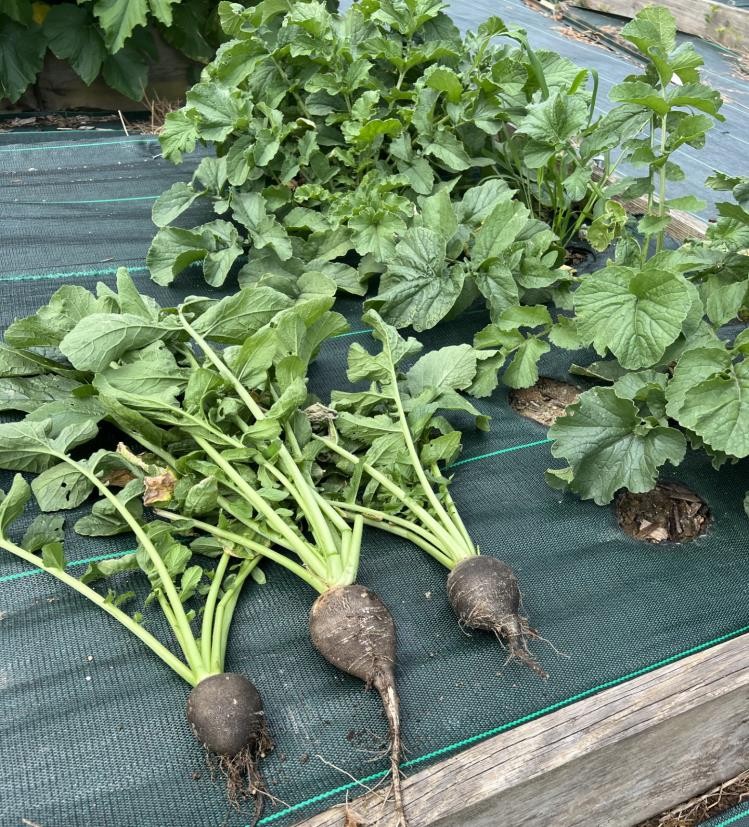
- ‘Round Black Spanish’ has a deep near-black skin and a white flesh and has been grown since the 16th century or before. It has a fairly hot flavor which is good raw or cooked.
Squash and Pumpkins
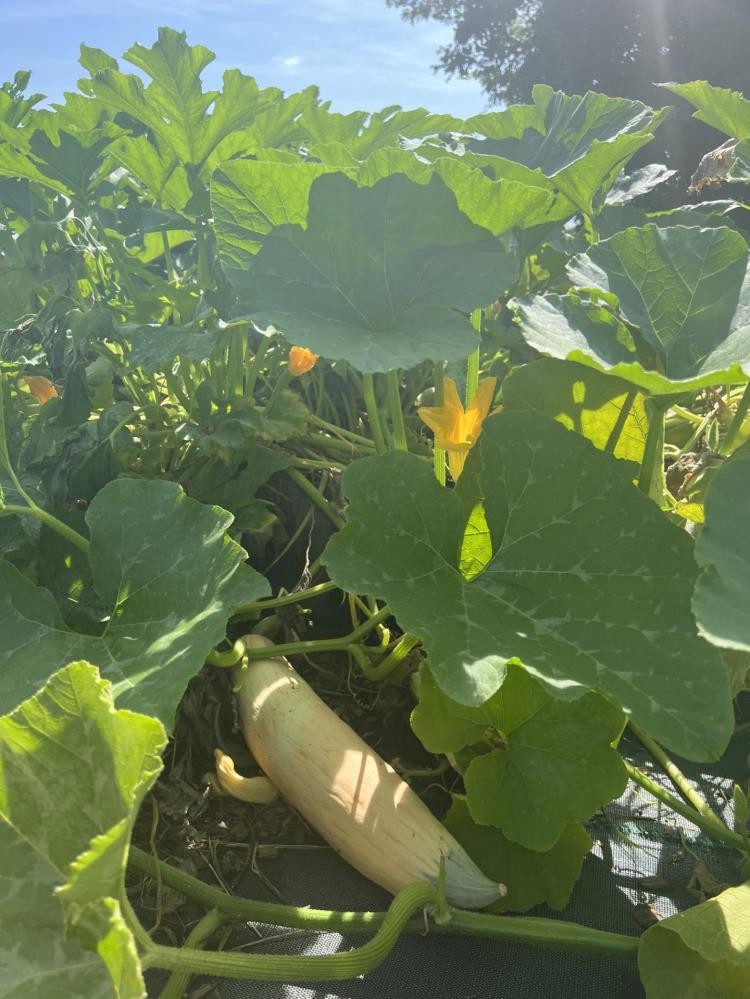
- ‘Candy Roaster’ squash is immensely popular in the Southeast. It has a banana-like shape with a blue tip and weighs around 10 lb.
- ‘Cushaw Green-Striped’ squash (C. mixta) has good-sized white fruits with green stripes and long, curved necks. It is good for pies and baking. Drought-tolerant and a good keeper.
- ‘Long White of Palermo’ zucchini is a summer squash that is a light green with white speckles and ranges from 12–15 in. The buttery texture with the nutty sweet flavor makes this variety popular.
- ‘Zucchino Rampicante’ is a famous Italian heirloom that can grow to 15 in. It is known for its mild, sweet taste and tenderness.
- ‘Connecticut Field’ is an old standard in field pumpkins. They are large and weigh 20–35 lb.
- ‘Rouge Vif d’Etampes’ is also known as the Cinderella pumpkin. This French heirloom pumpkin is productive and beautiful. The fruits are flat, burnt orange to red, and deeply ridged, ranging from 1–2 ft across.
- ‘Small Sugar’ is a sweet, tasty pumpkin that can grow up to 9 in. across on short, space-saving vines.
Tomatoes
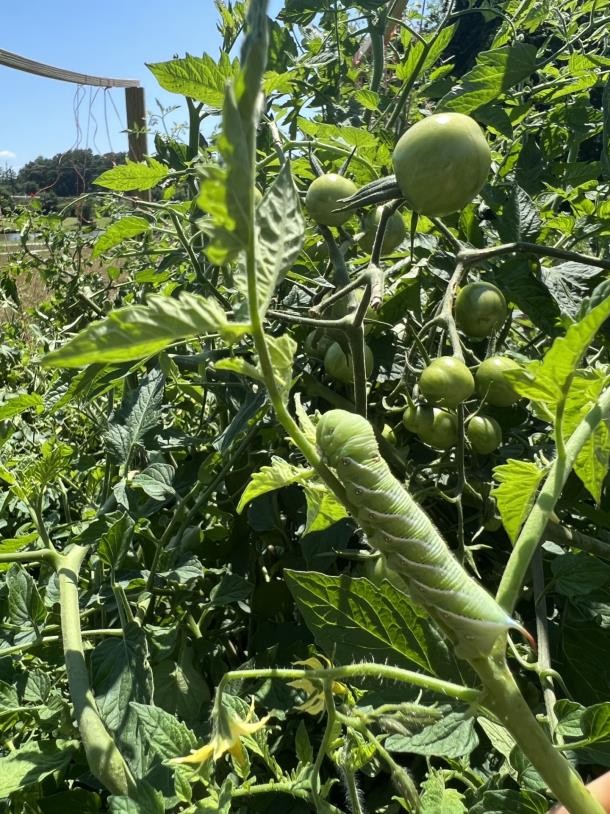
Tomatoes
- ‘Arkansas Traveler’ produces medium-sized, dark pink tomatoes on heat-tolerant vines.
- ‘Black Cherry’ resembles large purple-brown grapes. Once the fruit sets it is very prolific and has a rich flavor.
- ‘Bonny’s Best’ is known as one of the most respected canning varieties.
It is medium-sized, round, and meaty with lots of flavor. - ‘Brandywine’ is the most famous heirloom tomato. This Amish heirloom originated in Chester County, PA, in 1885. The flavor and texture are superb. Fruit quality stays high until late in the season. The plant often appears disease-resistant. This “potato-leaf” variety makes ½–1 lb pinkish red fruits.
- ‘Cherokee Purple’ is one of the most widely adapted of the “purple” or “black” tomatoes. The flesh inside is brick red and soft, and it has good flavor. It has delicious fruits that range from pink to brown to purple on indeterminate vines.
- ‘Cour di Bue’ (oxheart) is a beefsteak variety with excellent flavor and good size and weight.
- ‘Georgia Streak’ is a yellow and red beefsteak indeterminate heirloom from Georgia. It makes great-looking slices for summer salads.
- ‘German Pink’ originally started the heirloom movement in America. The “potato-leaf” plant has a floral sweet flavor and tender skin.
- ‘Pink Jazz’ is a large, tiger striped beefsteak that is light pink and yellow with a sweet tomato flavor. It’s sometimes described as having peach undertones.
- ‘Sweetheart cherry’ is a crisp strawberry-shaped option with heavy yields and great flavor. Let the fruit ripen on the vine to a deep red for the sweetest flavor or pick earlier for a tangy flavor.
- ‘Yellow Pear’ has prolific vines that produce loads of 1–2 in. pear-shaped fruits with good flavor.
Watermelon
- ‘Moon & Stars’ is another heirloom from the Amish. These 15–30 lb melons have sweet red pink flesh. The dark green rind is covered with bright yellow spots. The leaves of the plants are also spotted.
Reference
Russ, K., Bradshaw, D., & Smith, B. H. (2016). Heirloom vegetables. Clemson Cooperative Extension Home & Garden Information Center. https://hgic.clemson.edu/factsheet/heirloom-vegetables/
Status and Revision History
Published on Sep 18, 2024


























































